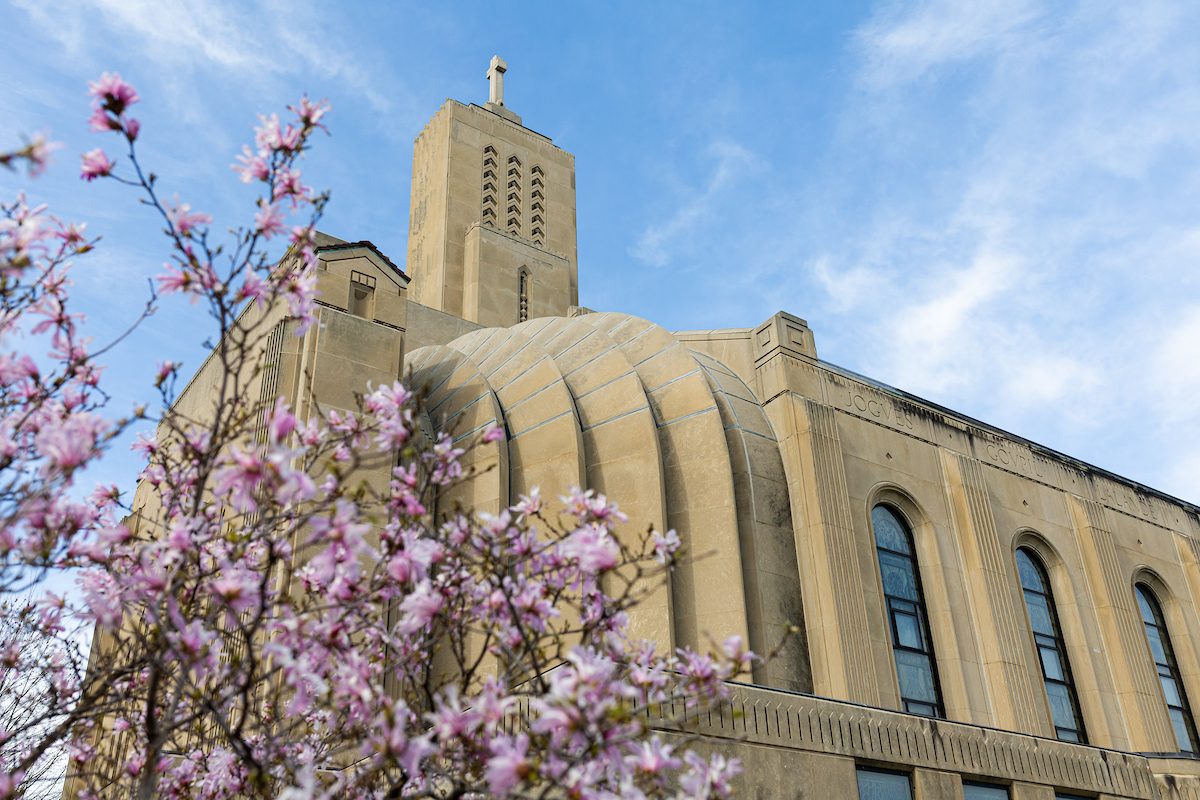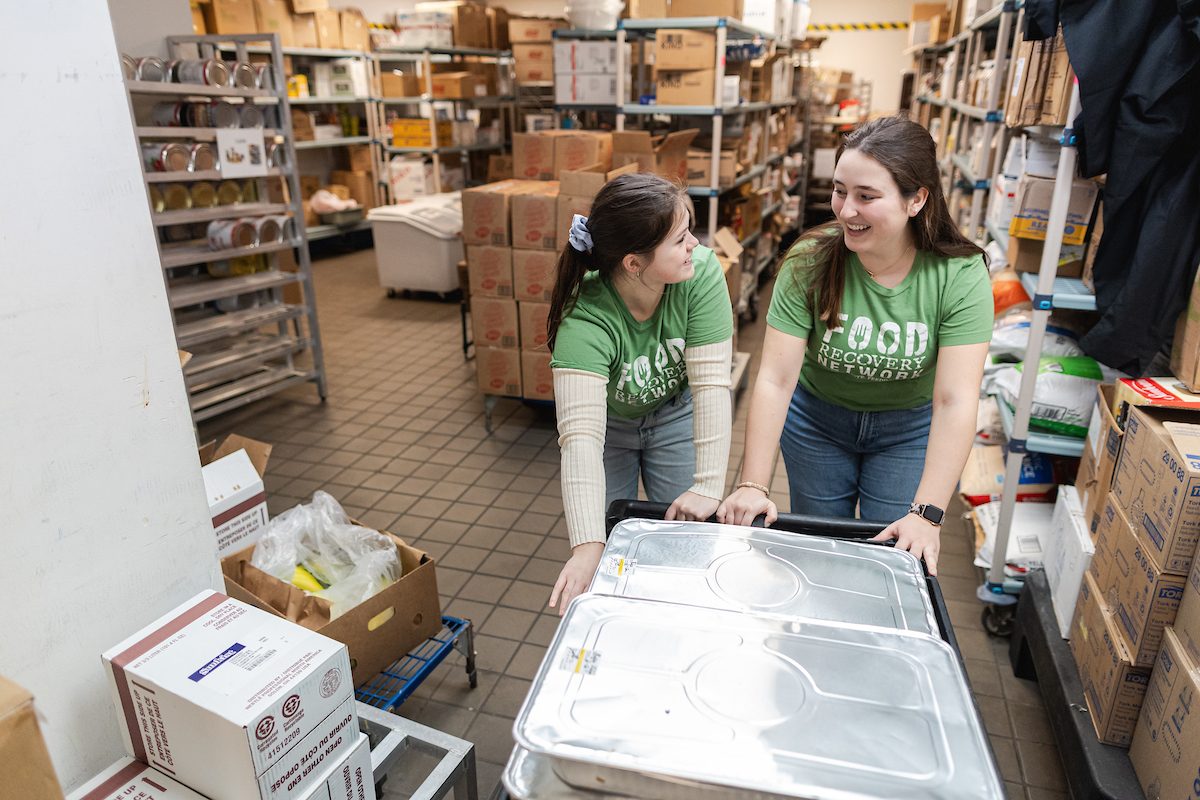Over six years, Jo Ann Rooney positioned Loyola for a strong future
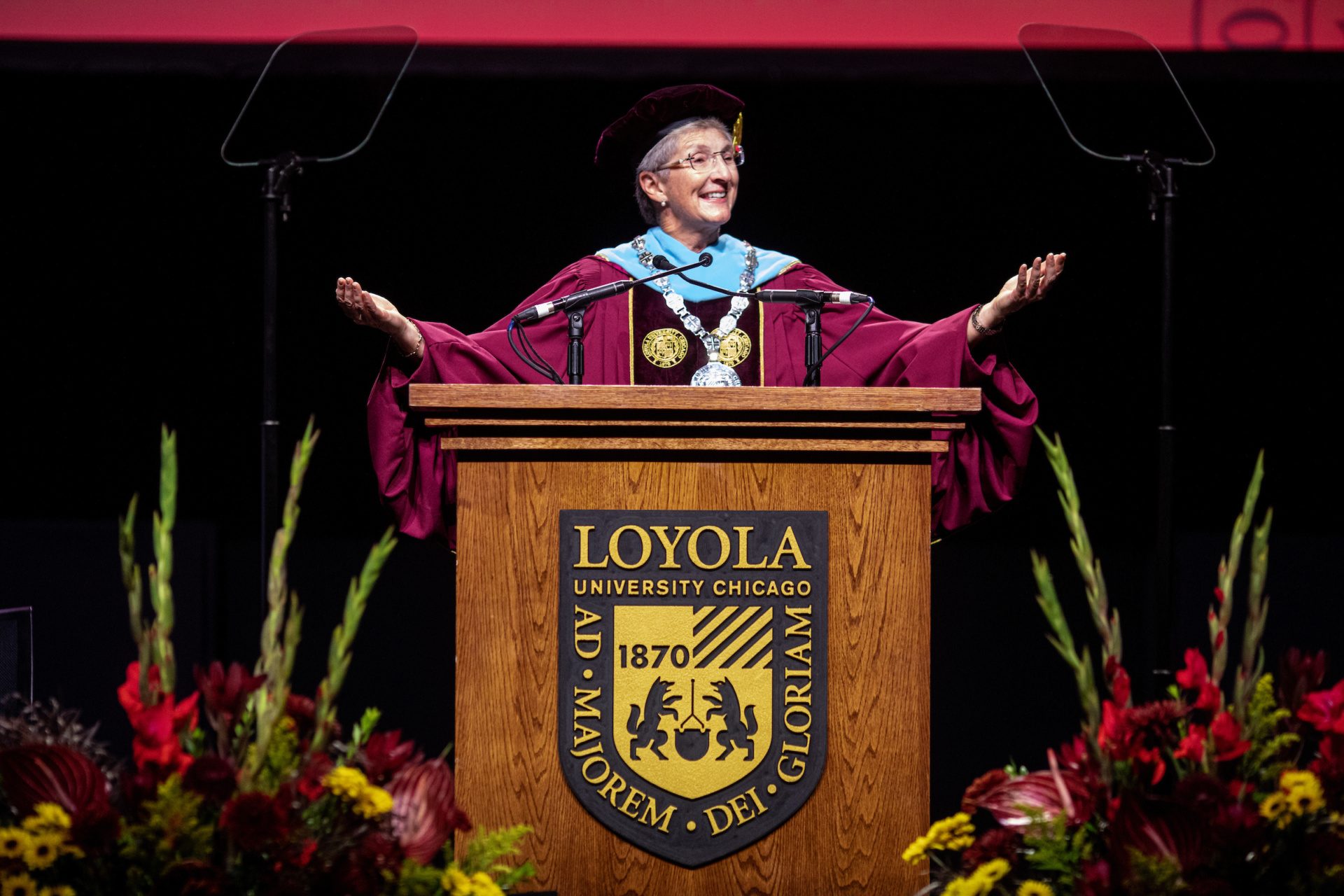
On May 23, 2016, Father Jim Prehn, S.J., rector of the Jesuit community at Loyola, stood before a packed Mundelein Auditorium to offer the opening prayer for an event that would reveal and welcome the newly chosen president of Loyola University Chicago. When Father Prehn referred to the new president as “she,” an audible gasp from the faculty, staff, and students overtook the room.
At the time, every president in Loyola’s 146-year history had been a Jesuit. But the seemingly routine prayer had revealed that for the first time, a lay woman had been chosen to lead the institution. Minutes later, the crowd would formally be introduced to Dr. Jo Ann Rooney as Loyola’s 24th president. And over the next six years, Dr. Rooney would establish herself as not only a champion of Jesuit values but a tenacious leader well equipped to handle some of the most daunting challenges facing higher education.
As she steps down from her position in 2022, Dr. Rooney leaves behind a legacy every bit as powerful as the 23 Jesuits who led Loyola before her.
That legacy includes maintaining a strong bond with the Archdiocese of Chicago and its archbishop, Cardinal Blase Cupich. “[Jo Ann Rooney has] put on full display the meaning of servant leadership and how to live the Jesuit ideal of accompaniment,” said Cupich at the 2022 Loyola Founders’ Dinner.
“The University has achieved much during [Dr. Rooney’s] historic presidency.”
“We are called to make a difference as ‘persons for others,’ to use what we learn to help one another. Service is a path we take from simply being educated to being loving.”
— Jo Ann Rooney , Loyola Magazine, 2018
During her presidency, Dr. Rooney always put Loyola’s Jesuit mission and values front and center. Loyola deepened investments in care for students by modernizing residence halls, strengthening academic programs, and aligning resources for expanded advising, wellness, and mental health resources for students on all campuses.
“Dr. Rooney brought to the presidency a deep and abiding Catholic faith and Jesuit orientation,” says Father Prehn, vice president and chief of staff. “She strove to balance cura personalis—care for the well-being of our students and the communities we serve—with cura apostolica—care for the well-being of the mission. You can’t do one without the other.”
In 2019, Loyola conducted a Mission Priority Examen, a community-wide Ignatian self-reflection on the ways in which the University infuses Jesuit values and identity into its mission of education, research, and service. Peer visitors praised the quality of teaching and scholarly work across the University and affirmed the ongoing commitment to social justice informed by faith.
Dr. Rooney also embodied Loyola’s mission and values in her own actions. As president she embraced a Jesuit style of leadership, particularly in her work with members of the president’s cabinet and other University leaders. “Dr. Rooney exemplifies the best of Jesuit leadership by seeking input and empowering leaders in the organization to make decisions and execute actions from their areas of expertise,” says Jeremy Langford, vice president of University Marketing and Communication.
“That’s a classic Jesuit style of leadership—collaborative and distributed,” says Langford. “To use an Ignatian concept, it’s a style based on accompaniment—shoulder to shoulder. She entrusts decisions to those leaders who know their areas best. She gives credit to others when things go well and accepts responsibility when they don’t.”
Innovation and collaboration
Under Dr. Rooney’s leadership, Loyola continued to evolve as a Jesuit, Catholic university by reimagining the ways students and scholars collaborate in interdisciplinary work to address complex scientific and social problems. Loyola created significant new programs and academic structures that encourage cross-disciplinary work, preparing students to become future leaders in their fields.
The Parkinson School of Health Sciences and Public Health
Dr. Rooney fostered the creation of the Parkinson School of Health Sciences and Public Health, collaborating with Provost Margaret Callahan, Kathy Bobay, now associate dean of faculty affairs at Parkinson, and other University and community leaders to solidify the concept of a school that would unify allied health sciences and public health expertise to address health inequities. “With a background in health care, Dr. Rooney immediately recognized the need and how it aligned with Loyola’s mission,” says Provost Callahan. Dr. Rooney worked closely with the late Bob Parkinson, former chair of Loyola’s Board of Trustees, and current board member Betty Parkinson, both alumni, on a landmark $20 million gift that would bring the concept to life.
“Dr. Rooney’s emphasis on innovative and collaborative interdisciplinary education, scholarship, and service is energizing,” says Elaine Morrato, professor and founding dean of the Parkinson School. “She recognized at a fundamental level that we must find new paths to meet the needs of today’s generation as they pursue careers in a dynamic health systems landscape.”
Arrupe College
Dr. Rooney marshaled institutional and philanthropic investment in Arrupe College at Loyola, building scholarship resources for students to attend Arrupe and pursue further studies. Arrupe’s curriculum was expanded to offer formal pathways to bachelor’s degree programs at other Loyola schools, including the Marcella Niehoff School of Nursing. A $1.5 million grant from the Robert R. McCormick Foundation will support student retention and recruitment, a pilot housing program, new support staff, and mentorship programming for Black students.
The School of Environmental Sustainability
In 2020, the Institute of Environmental Sustainability (IES) was elevated to the School of Environmental Sustainability (SES), adding a wealth of graduate programming and reflecting Loyola’s commitment to tackle climate change and environmental justice locally and globally. Dr. Rooney endorsed a budget to double SES’s faculty and staff over five years to build capacity and student enrollment.
Sustainability has been prioritized in the University’s Strategic Plan and will be a central element in the next comprehensive fundraising campaign. “I am grateful for Dr. Rooney’s leadership in prioritizing Loyola’s mission to build a more just and sustainable future,” says Nancy Tuchman, founding dean of SES.
The Rule of Law Institute
President Rooney worked closely with Michael Kaufman, the former dean of Loyola’s law school, and University Trustee Barry McCabe to develop the Rule of Law Institute. The institute will research and analyze rule of law issues to develop practical approaches and, together with University and external partners, aid in implementing and tracking those solutions.
The Rule of Law Institute was created with a generous gift from McCabe in 2020. Like the Parkinson School and SES, the Rule of Law Institute is structured for interdisciplinary engagement and will convene knowledge and expertise from across the University. “Dr. Rooney helped us look critically at the concept and pushed us to clarify not just the mission of the institute but its philosophy and operational needs,” says Kaufman. “She always keeps a keen eye on what is needed in the world.”
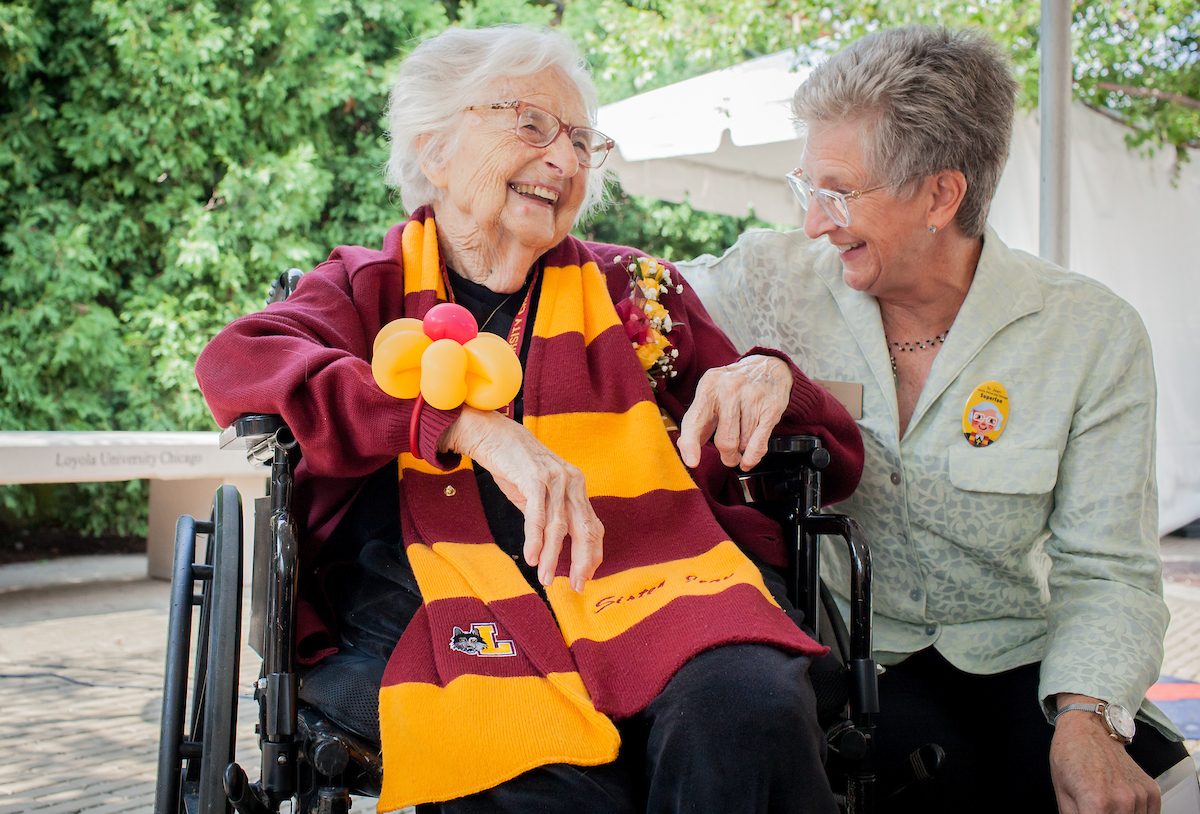
Fostering an inclusive community
The murder of George Floyd in the summer of 2020 spurred a new conversation about racial justice in America, and Dr. Rooney was not shy about taking a stand on behalf of Loyola. In a statement titled “From Grief to Action,” she expressed sadness and anger over the injustices committed against people and communities of color. Taking it a step further, Dr. Rooney considered how Loyola, as a university and a community, was impelled to bring its mission values to bear to address systemic racism.
In the ensuing days and weeks, students from the Black Cultural Center (BCC), White Coats for Black Lives, OurStreetsLUC, Student Government Loyola Chicago (SGLC), and the Black Graduate Student Alliance (BGSA) partnered to put forth recommendations in the document In Support of Black Students, which presented an opportunity for University leaders to engage and collaborate with students to tackle embedded racism on campus and in society. From those essential and sometimes difficult conversations, Dr. Rooney, with support from the Office of the Provost, established Loyola’s Anti-Racism Initiative (ARI).
Dr. Rooney also hired the University’s first vice president for institutional diversity, equity, and inclusion and announced the creation of the Institute for Racial Justice, an interdisciplinary hub for Loyola scholars and strategic partners to build deep relationships, accelerate transformational research and education, and create collective impact toward racial justice and equity. But these steps, she noted in an address to faculty last fall, are only the beginning.
“There is much more work to be done, and we will make mistakes,” Dr. Rooney said. “We have much more growing and learning to do as well, and it must continue—for all of us.”
Faculty diversity
Under Dr. Rooney’s leadership, Loyola recommitted itself to greater faculty diversity, implementing new recruitment processes and training to emphasize diversity as well as scholarly excellence and help hiring committees guard against unconscious bias.
Of the 84 new faculty members Loyola hired this past cycle, 47 percent identified as people of color and 29 percent came from underrepresented racial groups. Both rise above Loyola’s historical annual averages and reflect a commitment to diversity that deepens and broadens the academic experience for students.
“Whether they’ve been at Loyola a few months or a few years, these scholars bring much more than diversity to the faculty—they are injecting campus with fresh expertise and energy,” says Associate Provost Badia Ahad, who led the faculty diversity initiative and is also an associate professor in the Department of English. “In the English department alone, there are now five assistant professors who don’t identify as white and who teach subjects for which Loyola never had specialists before.”
Student diversity
Loyola increased its educational outreach to extend and deepen initiatives to recruit students from diverse backgrounds and support their success. Loyola set undergraduate enrollment records each year of Dr. Rooney’s presidency, and the student body became increasingly diverse, though Dr. Rooney often reminded the community that there is “much more work to do.”
The class of 2025 is the largest and most diverse class in Loyola’s history, with more than 43 percent of students identifying as persons of color.
Loyola’s careful, analytical approach and the extraordinary efforts of faculty, staff, and students helped minimize the on-campus spread of COVID-19. Thanks to Loyola’s early adoption of surveillance testing and vaccination requirements, campus operations continued to expand and the University slowly progressed back toward normal in-person operations. Meanwhile, Dr. Rooney’s careful stewardship helped to lessen the financial impact of the pandemic, which for some colleges and universities had been dire.
COVID-19’s financial impact on Loyola in 2021 resulted in a revenue shortfall of more than $95 million, according to Wayne Magdziarz, Senior Vice President and Chief Financial Officer at Loyola. “Under Dr. Rooney’s leadership, a multi-phased plan to reduce expenses only after solid data verified revenue loss allowed Loyola to preserve jobs and only minimally impact our staff and faculty, Magdziarz said. “It was a powerful example of cura personalis at a time when the University was facing unprecedented financial challenges.”
“COVID challenged the entire Loyola community. Dr. Rooney stayed present and focused as she lead us through every challenge until Loyola learned to both live with and thrive with COVID,” says Thomas Kelly, senior vice president for administrative services. “The constant collaboration enabled administrators, faculty, staff, and students to share information and approach every new challenge in a collaborative, decision-oriented way. We learned a lot together that will help us map paths of future innovation.”
“I, as president, and we, as the Loyola community, are outraged at the acts of violence perpetrated by police against people of color in the United States... what are we going to do about contributing to healing this cancer within American society? Loyola University Chicago is called to reconcile, repair, heal, and educate. We are called to act.”
— Jo Ann Rooney , May 2020
Building a better Loyola
Dr. Rooney presided over a significant expansion of Loyola’s student body and programming. At a time when many other schools were struggling to attract and retain students, Loyola achieved record undergraduate enrollments each year during the Rooney presidency. Substantial investments were made in capital projects, financial aid, student support, and campus improvements.
Campus improvements
Vital capital projects were accomplished during the Rooney Presidency, and Loyola continued to be a national leader in campus sustainability by achieving ambitious carbon-reduction goals.
A major renovation of the iconic Cudahy Science building on the Lake Shore Campus included the refurbishing of its beautiful observatory dome. Classrooms were made more open, flexible, and equipped with updated technology, while lab expansion and enhancement increased the opportunities for students to collaborate with faculty and mentors for advanced research.
The expansion of the John Felice Rome Center enabled the University to position itself to work harder and become more sophisticated in educating today’s youth and tomorrow’s leaders to tackle urgent social problems. The expansion will build beyond bricks and mortar to include the development of more interdisciplinary courses informed by fieldwork and service outreach.
Loyola made significant strides in reducing its environmental footprint during President Rooney’s tenure. The University advanced toward the goal of being carbon neutral by 2025 with a power purchase agreement under which 100 percent of electricity on all Chicagoland campuses will be procured from clean, renewable, fossil-fuel free solar power. These achievements moved the University closer to receiving a STARS Platinum rating and placed Loyola in the top 5 percent of green campuses in the country.
With Dr. Rooney’s support, the University ratified a policy to divest its endowment funds from fossil fuel industries, and as president she signed on to a pledge on behalf of Loyola to join Pope Francis’ global climate change initiative.
Financial stewardship and fundraising
Strong financial stewardship enabled Loyola to solidify the investments and progress of the previous decade. Loyola implemented a three-year budgeting cycle that enables the University to better navigate the ups and downs of the economy and enrollment trends. The University reduced institutional debt by nearly 50 percent and increased its bond ratings to exemplary levels. Wayne Magdziarz, senior vice president and chief financial officer, implemented regular updates to University governance bodies and the community to increase transparency, understanding, and confidence. Dr. Rooney and Magdziarz worked with the Board of Trustees to elevate investment strategies and policies, and in 2021, Loyola’s endowment reached $1 billion for the first time.
At a mostly tuition-driven school like Loyola, grants and philanthropy provide critical resources for strategic, mission-critical investment. Dr. Rooney collaborated with deans, donors, and advancement leaders to develop forward-thinking proposals that deepen mission and impact and make the University’s future more secure. Her tenure saw multiple seven- and eight-figure gifts to the University, and she led the development of student-centered programming proposals that helped secure the largest gift in Loyola history, a $100-million commitment from John and Kathy Schreiber.
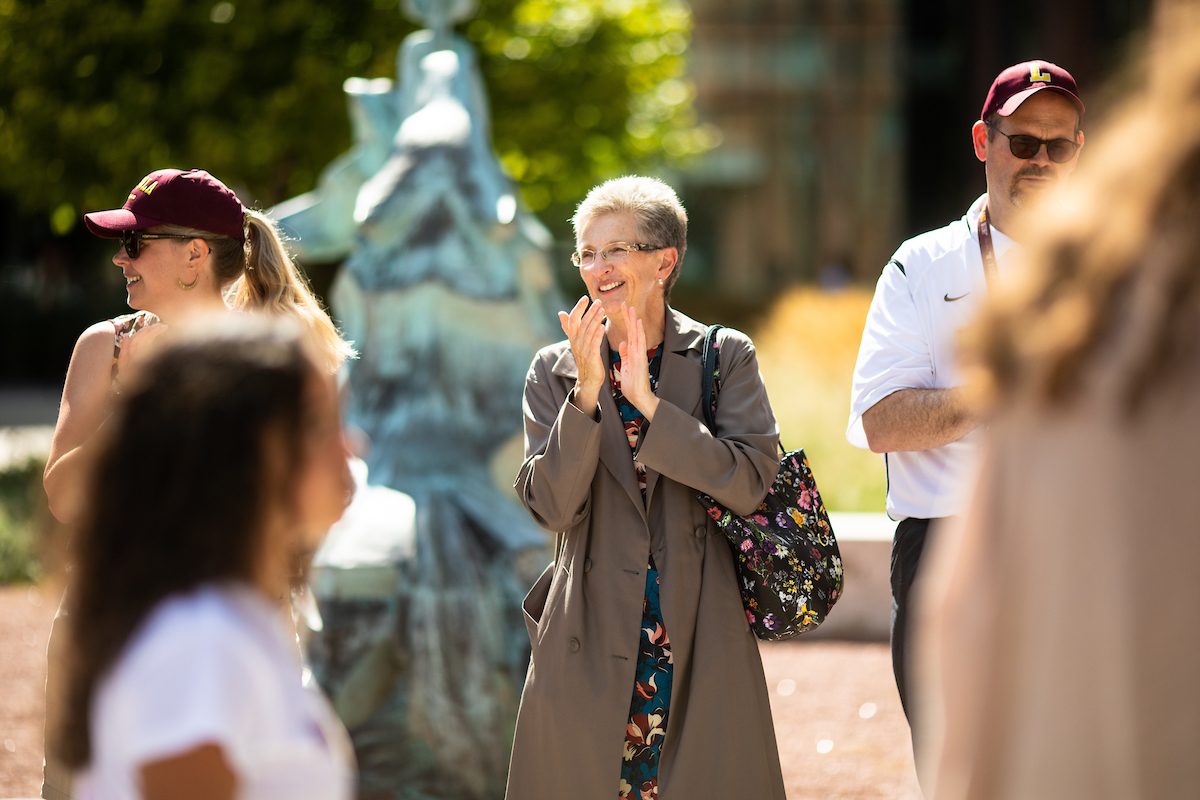
Go Ramblers!
When Dr. Rooney took office, it had been decades since the Loyola Ramblers were a national name in college basketball. But three times in the past five years, the men’s basketball team had dramatic runs in the NCAA tournament—making the Final Four in 2018, the Sweet Sixteen in 2021, and the first round in 2022. While Dr. Rooney may not have been offering the players tips on their shooting, she nonetheless played a critical role in supporting the growth of Athletics, seeing it as another avenue to shine a national spotlight on Loyola.
“Dr. Rooney has been incredibly supportive of all of our athletics programs across the board, and on top of that, she has been one of our biggest fans” says Steve Watson, director of athletics. “She worked hard to balance funding priorities across campuses and helped nurture philanthropic commitments to expand practice and training facilities. Her commitment to athletics is unmatched and her work behind the scenes has been instrumental in the rise to prominence of our athletics programs, culminating with a move to the Atlantic 10 Conference in July 2022.”
While additions like the Alfie Norville Practice Facility helped improve player performance, Rooney’s loudest cheers were reserved for the dominance of the Ramblers in the NCAA’s academic rankings. She rarely missed an opportunity to highlight the fact that year after year, Loyola is among the top-ranked colleges in Graduation Success Rate (GSR). In 2020, for the fifth year in a row, Loyola had a GSR of 99 percent, giving the Ramblers a number one ranking nationally—putting the University in the company of schools like Harvard and Yale.
Perhaps the biggest success of Loyola Athletics is yet to come, as Dr. Rooney announced in December 2021 that Loyola would depart the Missouri Valley Conference for the Atlantic-10 (A-10), a 14-university, 21-sport league regarded as one of the best conferences in the country.
Preparing for the future
As Dr. Rooney prepares to step down, she leaves the University in many ways on strong footing. One of her lasting legacies will be the implementation of Loyola’s new Strategic Plan, which outlines how Loyola can continue to be a catalyst for change in society.
“Dr. Rooney speaks often of the Jesuit concept of the magis, the persistent search for deeper insights, greater excellence, and greater justice,” says Provost Callahan. “That is evident in the new strategic plan she helped to frame and in the way she encouraged the community to help it blossom. It lays out a vision of how Loyola extends its work of education, service, and research to address urgent challenges of the world.”
With other areas of growth and innovation already set in motion, Loyola has much to look forward to as it prepares to welcome its next leader.
“The Rooney presidency built on Loyola’s foundational legacy of excellence and service to sustain, strengthen, and grow a community of scholars driven by Jesuit values and characterized by relentless inquiry, deep care and compassion for students, and the good of the larger society,” says Susan Sher, chair of Loyola’s Board of Trustees.
